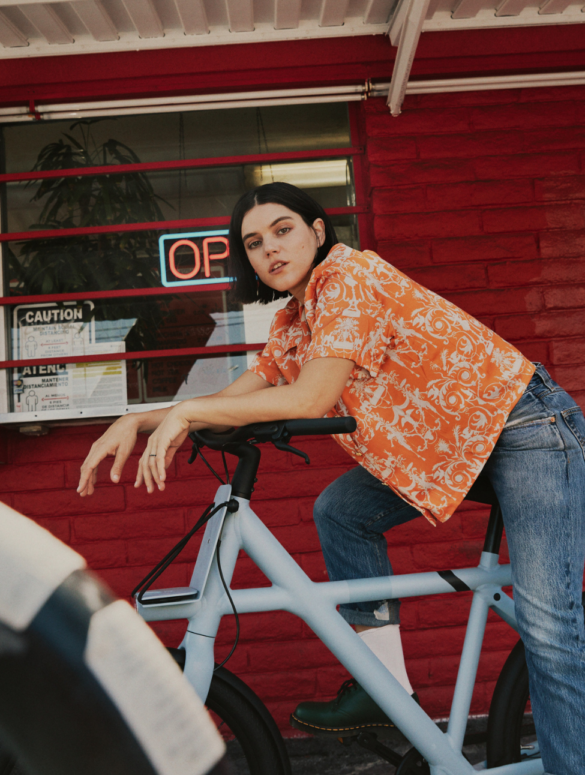Text by Chris Morris
Images courtesy of VanMoof
In 2009, a pair of brothers from The Netherlands had an idea for a different type of city bike. Taco Carlier, while riding in New York, noticed that, unlike Amsterdam, the streets of Manhattan were crowded with cars, not bikes. He and brother Ties soon got to work on a device that would amplify people’s peddling power and actively protect against theft.
It wasn’t long before their creation was a hit with riders around the globe.
VanMoof, the company founded by the Carlier brothers, has attracted roughly 200,000 riders since its early days, but the onset of the pandemic has made the company more popular than ever. Sales tripled once COVID-19 struck and the company sold more bikes in the first four months of 2020 than it had in the previous two years combined. (The company’s goal is to get 10 million people on its bikes over the next five years, if only for a test ride.)

VanMoof has stores in Amsterdam, Berlin, London, New York, Paris, San Francisco, Seattle, and Tokyo – and last September, it opened a new location just blocks from the Santa Monica pier in Los Angeles.
LA might seem a curious choice, but VanMoof’s Austin Durling says the company sees a lot of promise.
“Los Angeles has a lot of potential as a great biking city, especially on the west side,” he says. “There are great bike lanes in Santa Monica and Venice. Some of my favorite rides have been along the beach coming down from Venice.”
VanMoof bikes are meant to fill the gaps that cars often occupy. Have to run an errand somewhere close by? Off to see a friend who lives just a couple miles away? Need to pick up just one or two things from the store? VanMoof bikes aim to make you opt to peddle rather than drive.
Part of the secret is making it easier to get from Point A to Point B. VanMoof’s e-bikes supplement peddle power with electric propulsion when you want, meaning you can make it up a hill without exhausting yourself (and becoming a sweaty mess) or, on flatter terrains, go a lot faster than you normally would on a bike – one upcoming model will go as fast as 31 mph. The bikes also switch between their four gears automatically, making it easier for people to just enjoy the ride.


E-bikes can be popular with thieves, though, so VanMoof also offers robust anti-theft features, such as a kick-lock system that locks the bike and ensures it can’t be moved more than a few inches. The bike itself weighs 45 pounds, so thieves are unlike to simply carry it away. If they do, though, VanMoof offers a program where it will send “bike hunters” out to find your stolen e-bike using the company’s GPS tracking technology. If they can’t find it within two weeks, they’ll replace the bike free of charge.
Prices for a VanMoof start at just under $2,300 and go as high as $3,600. That’s in the same area as competitors, but it’s a bit out of the range of an impulse purchase. That’s why the company encourages customers to take them out for 30-minute test rides from its retail locations (or roughly 40 Workshop hubs, held in bike stores in cities where it doesn’t have a retail branch).
At the Santa Monica store, that means a ride along the beach, which can remind people (especially those who don’t have the funds for a convertible) of the joys of fresh air.
“We really think because this is such a car-focused city that people are itching for an alternative,” says Durling. “They just don’t know it yet. … It might not replace the car in LA completely, but it could reduce car use.”
While there’s no research on whether riding a bike is actually faster in Los Angeles, Durling notes to curious customers that the time reflected in your GPS app is going to be exactly how long it takes.

“There are no delays or random traffic stoppages,” he points out.
The bikes’ batteries typically last between 30 and 90 miles, depending on how much the boost is used and the number of hills it must conquer. They’re also an e-bike that doesn’t look like an e-bike, hiding the electric components within the frame and making the LED matrix display subtle (and something only the rider can see).
Because of the pandemic surge in demand, there’s currently a five week wait for delivery, but the company is hoping to shorten that (something that’s not as impossible as it might seem, since it controls most of the components in its supply chain). COVID, though, made people more eager to explore the outdoors. And e-bikes were in the right place at the right time.
“I think that across the globe people were looking for different ways to get around the city,” says Durling. “They maybe had a little more free time. They maybe were uneasy about taking public transportation. People were revisiting their relationship with where they lived in the world and had different priorities.”


